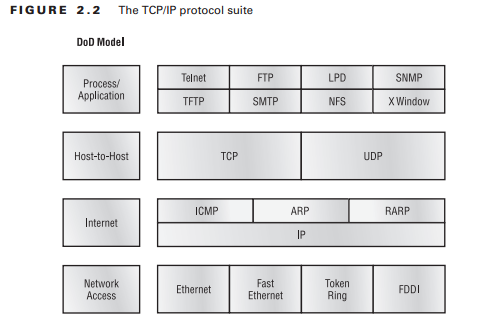TCP/IP protocol suite can be modelled related to OSI. Instead seven layer of OSI, in TCP/IP protocol suite (DoD: Department of Defense), it only has four layers.

1. Proces/Application layer in TCP/IP or DoD model integrates the functions of Application, Presentation, and Session Layer of OSI model : node-to-node communication and control of user-interface.
2. Host-to-Host layer in TCP/IP or DoD model represents the functions of Transport Layer of OSI model : transmission service, reliable communication, ensuring error-free delivery of data.
3. Internet Layer in TCP/IP or DoD model represents the functions of Network Layer of OSI model : logical transmission, IP addressing, routing packets across different network.
4. Network Access Layer in TCP/IP or DoD model represents the functions of Data Link Layer + Physical Layer of OSI model : monitors data exchange between host and network, hardware addressing, defines protocol for the physical transmission of data.
TCP/IP protocol suite in DoD model.

Process/Application Layer
1. Telnet : Terminal Emulation, Allows machine (telnet client) to access resources of other (remote) machines (telnet servers).
2. FTP : File Transfer Protocol, Allows user to transfer transfer file between any machines using it. Protocol + Program (Allow user to do performs certain task by hand).
3. TFTP : Trivial File Transfer Protocol, simple version of FTP, reduced functions and security, but faster than FTP.
4. NFS : Network File System, Protocol specializing in File Sharing, allows different types of file systems to interoperate. Ex : NSF server running in NT server and client in unix allows user to access same file with their normal file system in normal way.
5. SMTP : Simple Mail Transfer Protocol handles email, uses spoole or queued, model of mail delivery.
6. LPD : Line Printer Daemon, Printer Sharing
7. X-Window : Client server operation, Display things trough window server on another computer .
8. SNMP : Simple Network Management Protocol collects and manipulates valuable network information.
9. DNS : Domain Name Service, resolves hostname, changes IP address into hostname and hostname into IP address.
10. DHCP : Dynamic Host Configuration Protocol assigns IP addresses to host. BootP : hardware address must be inputted manually in BootP table. DHCP Provides Information : IP address, Subnet Mask, Gateway address, DNS server, Domain Name, WINS information. using UDP to send broadcast message on FF:FF:FF:FF:FF:FF and 255.255.255.255.
Host-to-Host Layer
TCP ( Transmission Control Protocol )
takes information from application and breaks them into segments, numbers and sequences segments, so that segments can be putted back together in order.
UDP ( User Datagram Protocol )
unreliable protocol, only break information into segments but doesn’t number/sequences the segments, then send it off to destination without any acknowledgement.

Internet Layer
1. IP : Internet Protocol = Internet Layer. it looks each address, using the table, choose the best path to deliver packets.
2. ICMP : Internet Control Message Protocol, provides information about network problems : Destination Unreachable, Buffer Full, Hops, Ping, Traceroute.
3. ARP : Address Resolution Protocol : finds hardware address of known host ip address.
4. RARP : Reverse Address Resolution Protocol : resolves MAC address to ip address.
5. Proxy ARP : Helps Machine reach destination without configuring routing or default gateway.
source : CCNA Study Guide Exam